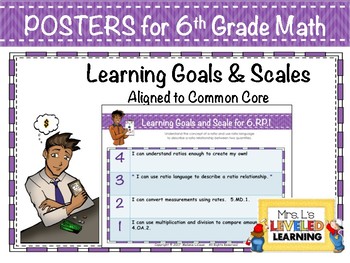6th Grade Math Marzano Learning Goals and Scale Posters for Differentiation
- PDF
Description
Learning Goals and Scales are the ultimate Standards Based Grading tool! They don't just motivate a Growth Mindset, they define how students can demonstrate mastery. Every learning standard is broken down into 4 levels of Differentiation. These Posters lead students up a progressive learning path that mirrors the way they develop concepts. Aligned to Bloom’s or Marzano’s Taxonomy of cognitive skills. From easiest-hardest: (Recall/Retrieval, Comprehension, Analysis/Application, and Knowledge Utilization/Synthesis).
4 Learning Goal “I Can” Statements for each standard:
4. Level 4 indicates an advanced knowledge of the skill.
3. Level 3 represents proficiency in each math standard. see the stars*
2. Level 2 will include content from the previous grade level and new vocabulary that must be applied correctly for mastery of level 3.
1. Level 1 will either be derived from sub-skills of the standard, or from the background knowledge of earlier grade levels.
Students review EASY learning goals from previous grade levels in sections, “Levels” 1 and 2. These first two levels set them up to see simple examples of the connections between what they know, and what they must do this year. “Level” 3, or section 3, includes questions they should master this year. “Level” 4 includes optional enrichment tasks for your gifted and talented thinkers.
How to Use these Posters:
1. Print the ones you are currently planning instruction for. (color/black and white)
*Option: Display them digitally on a white board while you teach!
2. Briefly review levels 1, 2, and 3 (in that order) so your students can access prior knowledge and pre-assess themselves.
3. Refer to the poster while you teach and practice new skills. Students will see their progression.
*Additional Options:
4. Offer examples for each level of the proficiency scale (See Assessments linked below!)
Assessments can be used as pre- and post-tests for students to demonstrate and document mastery and growth.
5. Refer to the levels 1 and 2 to create appropriate modifications for targeted instruction or small group practice.
6. Use Level 4 to modify or create enrichment tasks for your gifted and talented students.
THIS DOCUMENT INCLUDES:
* PDF version for printing.
* This document is strictly aligned to the original Common Core standards and the content is NOT EDITABLE.
Click here to see if your State standards align to Common Core
THIS DOCUMENT INCLUDES:
1. One color poster with learning goals and scale for every standard.
2. One black & white poster with learning goals and scale for every standard.
3. Five editable blank color posters, one for each cluster (RP, NS, EE, G, SP), if you’d like to write your own learning goals for the scale with your students.
4. Five editable blank black & white posters, one for each cluster (RP, NS, EE, G, SP).
This document is strictly aligned to the original Common Core and the content is NOT EDITABLE. However there are BLANK pages that may be edited to create your own scales with the same colors and graphics.
For directions on editing the pages in your pdf. document. CLICK HERE
For more information on using Marzano Scales, visit
Mrs. L's Leveled Learning website
Click here to see a video of How to Teach a 6th Grade Math Scale.
* This document is strictly aligned to the original Common Core and the content is NOT EDITABLE.
For an EDITABLE version of the complete document follow this link...
6th Grade Math Posters with Proficiency Scales - EDITABLE
6th Grade Math BUNDLE with Learning Goals and Scales - EDITABLE
6th Grade Math Assessment with Learning Goals and Scales
6th Grade Math Madness Interactive Power Point Game!
6th Grade Math Student Portfolio with Learning Goals and Scales
6th Grade Common Core Math Tracking Sheet with Scales
a title="6th Grade Common Core Math Quizzes" href="https://www.teacherspayteachers.com/Product/6th-Grade-Common-Core-Math-Quizzes-All-Standards-2081223">6th Grade Common Core Math Quizzes
6th Grade ELA Assessment with Learning Goal 6.RL.1 and Scale - FREE
6th Grade ELA Posters with Marzano Scales
6th Grade ELA Student Portfolio Pages with Marzano Scales - FREE!





